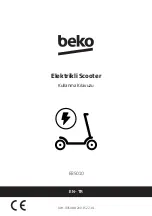
Basic Rider Optimization Training for the Segway
HT
Page 59 of 106
Instructor Guide and Participant Workbook
Rev 3.5i - January 2004
© Segway LLC 2002
P/N 1707100001aa
Explain
: “I will be alongside you. I will insert the fault insertion Key, simulating a disconnect between
the Control Shaft Cords and the Controller Boards. I want you to remain on the Segway HT until it is
stopped, then step down off the Platform with both feet. I will be holding the Segway HT when it slows
and comes to a stop. You have approximately 10 seconds to come to a controlled stop and safely
step off during a Safety Shutdown, so don’t panic or rush, but be prepared to step off as soon as you
safely can.
Make sure
the rider is wearing a helmet, and that you are holding the Control Shaft securely during
the deceleration and stick shakes. Instructor should be prepared to receive all the weight of the rider.
Important
: Emphasize that the rider must step down, and remove BOTH feet from the Platform.
Otherwise, she is still giving input into the system, and the system will respond to any
requests to stay balancing.
Important
: If the aft pitch angle exceeds 20
°
backward, the Segway HT will shut down rather than
accelerating in reverse. This is an important safety feature. Ensure the rider does not lean
over the Handlebar as the Segway HT is limiting speed.
Repeat the experience for each rider.
Say:
“Never ride through a Safety Shutdown. Recognize the alerts and signals, slow down and stop,
then safely step off.”
Torque and Traction
If the Segway HT encounters a condition in which it can no longer perform in an acceptable manner,
it will disable power. This is the case if pitch or roll parameters are exceeded or if the wheels spin
because of traction loss.
Demonstrate
roll or pitch parameters being exceeded, depending on the Segway HT model you
have.
i or p Series
: Stand to the side and lean the Segway HT sideways without allowing the Platform to tilt
forward or backward. Lean it over until it shuts down.
e Series
: From E-Stand, push the Segway HT backward. As you continue to push the Segway HT
backward, the wheels will move and eventually, the pitch parameter will be exceeded. The Segway
HT will transition to Power Assist Mode and torque will no longer be delivered to the wheels.
The Segway HT tires must grip the ground for the machine to stay upright. If the tires cannot generate
a reaction force, the Segway HT cannot stabilize itself. The system assesses how fast the wheel is
accelerating. If the wheel accelerates too fast, then the Segway HT concludes that it cannot balance
effectively and temporarily nullifies the motor torque to allow the wheel to regain traction. Once the
wheel has slowed down, the torque is reengaged.
Avoid slippery surfaces
A person slips when stepping on ice or other slippery surfaces because the person loses traction—
the person’s shoe does not grip the surface. The Segway HT can slip in the same way. If a tire loses
traction, then the Segway HT cannot move to stay upright and the rider could fall. To be safe, you
must avoid slippery surfaces, such as ice, wet floors, wet grass, or any other surface that you might
slip on if you were running. Also, remember that wet, soapy, and oily tires can lose traction and slip
on any surface, so use extreme caution.
















































